病历书写-皮肤科病历
- 格式:doc
- 大小:23.50 KB
- 文档页数:2
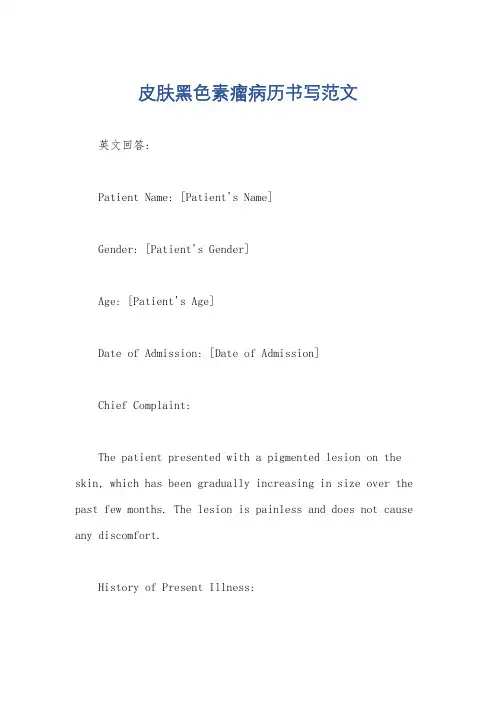
皮肤黑色素瘤病历书写范文英文回答:Patient Name: [Patient's Name]Gender: [Patient's Gender]Age: [Patient's Age]Date of Admission: [Date of Admission]Chief Complaint:The patient presented with a pigmented lesion on the skin, which has been gradually increasing in size over the past few months. The lesion is painless and does not cause any discomfort.History of Present Illness:The patient noticed the pigmented lesion on the skin about 6 months ago. Initially, it was small and did not bother the patient. However, over time, the lesion has grown in size and has become more prominent. The patient denies any associated symptoms such as itching, bleeding, or changes in color.Past Medical History:The patient has no significant past medical history. No history of chronic illnesses, surgeries, or allergies.Family History:There is no significant family history of skin conditions or melanoma.Social History:The patient is a non-smoker and does not consume alcohol. The patient works indoors and has limited sun exposure. No history of tanning bed use.Physical Examination:On examination, there is a well-defined, irregularly shaped, pigmented lesion on the patient's skin. The lesion measures approximately 1.5 cm in diameter. It has variegated colors with shades of brown and black. The lesion is asymmetric and has an irregular border. There is no associated lymphadenopathy.Differential Diagnosis:1. Melanoma.2. Benign melanocytic nevus.3. Seborrheic keratosis.4. Lentigo maligna.Investigations:1. Dermoscopy: Dermoscopic examination of the lesion reveals irregular pigment network, asymmetric structure, and multiple colors, which are suggestive of melanoma.2. Biopsy: A punch biopsy of the lesion was performed to confirm the diagnosis.Diagnosis:Based on the clinical presentation and dermoscopic findings, the diagnosis of melanoma is suspected. The biopsy results will confirm the diagnosis.Treatment Plan:The patient will undergo surgical excision of the lesion. The excised tissue will be sent for histopathological examination to determine the depth of invasion and presence of any metastasis. Further treatment will be planned based on the histopathology report.Prognosis:The prognosis of melanoma depends on various factors, including the stage of the disease, depth of invasion, and presence of metastasis. Early detection and treatment significantly improve the prognosis.中文回答:患者姓名,[患者姓名]性别,[患者性别]年龄,[患者年龄]入院日期,[入院日期]主诉:患者主诉皮肤上有一个黑色素沉着的病变,过去几个月逐渐增大。
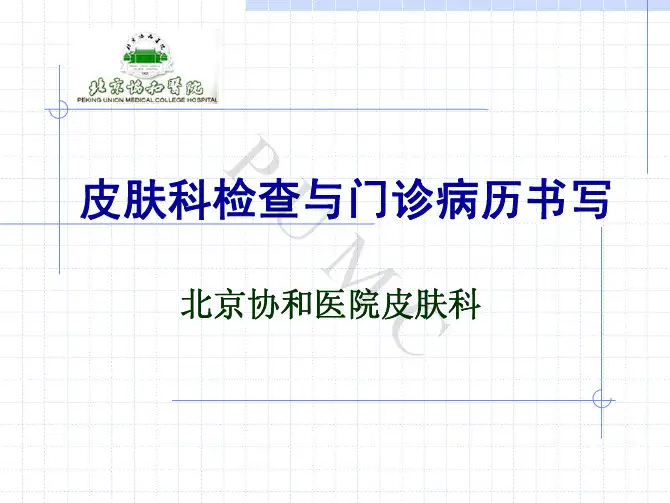
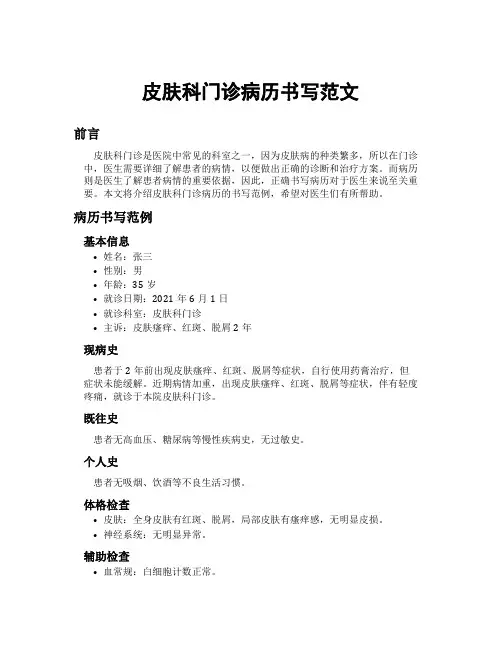
皮肤科门诊病历书写范文
前言
皮肤科门诊是医院中常见的科室之一,因为皮肤病的种类繁多,所以在门诊中,医生需要详细了解患者的病情,以便做出正确的诊断和治疗方案。
而病历则是医生了解患者病情的重要依据,因此,正确书写病历对于医生来说至关重要。
本文将介绍皮肤科门诊病历的书写范例,希望对医生们有所帮助。
病历书写范例
基本信息
•姓名:张三
•性别:男
•年龄:35岁
•就诊日期:2021年6月1日
•就诊科室:皮肤科门诊
•主诉:皮肤瘙痒、红斑、脱屑2年
现病史
患者于2年前出现皮肤瘙痒、红斑、脱屑等症状,自行使用药膏治疗,但症状未能缓解。
近期病情加重,出现皮肤瘙痒、红斑、脱屑等症状,伴有轻度疼痛,就诊于本院皮肤科门诊。
既往史
患者无高血压、糖尿病等慢性疾病史,无过敏史。
个人史
患者无吸烟、饮酒等不良生活习惯。
体格检查
•皮肤:全身皮肤有红斑、脱屑,局部皮肤有瘙痒感,无明显皮损。
•神经系统:无明显异常。
辅助检查
•血常规:白细胞计数正常。
•尿常规:正常。
•皮肤刮片:真菌检测阳性。
诊断
•皮肤真菌感染。
治疗方案
•外用抗真菌药膏治疗。
随访计划
•患者每周复诊一次,观察病情变化。
结语
以上是皮肤科门诊病历书写的范例,希望对医生们有所帮助。
在书写病历时,需要注意的是,要详细了解患者的病情,包括病史、体格检查、辅助检查等方面,以便做出正确的诊断和治疗方案。
同时,书写病历时也要注意语言简洁明了,避免使用过于专业的术语,以便患者和其他医生能够理解。

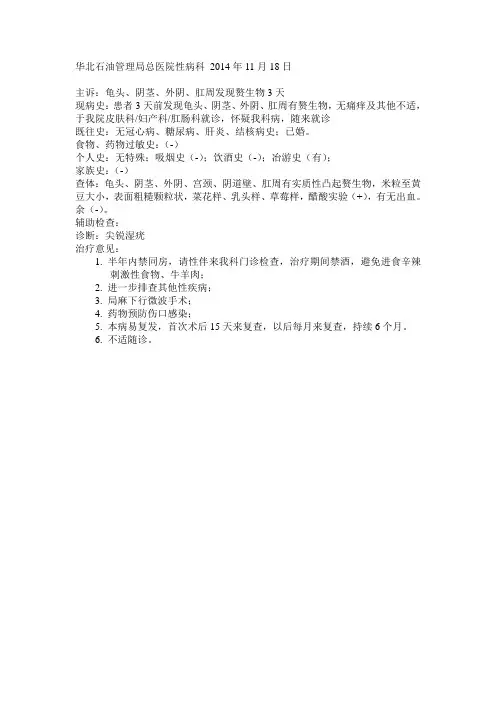
华北石油管理局总医院性病科2014年11月18日
主诉:龟头、阴茎、外阴、肛周发现赘生物3天
现病史:患者3天前发现龟头、阴茎、外阴、肛周有赘生物,无痛痒及其他不适,于我院皮肤科/妇产科/肛肠科就诊,怀疑我科病,随来就诊
既往史:无冠心病、糖尿病、肝炎、结核病史;已婚。
食物、药物过敏史:(-)
个人史:无特殊;吸烟史(-);饮酒史(-);冶游史(有);
家族史:(-)
查体:龟头、阴茎、外阴、宫颈、阴道壁、肛周有实质性凸起赘生物,米粒至黄豆大小,表面粗糙颗粒状,菜花样、乳头样、草莓样,醋酸实验(+),有无出血。
余(-)。
辅助检查:
诊断:尖锐湿疣
治疗意见:
1. 半年内禁同房,请性伴来我科门诊检查,治疗期间禁酒,避免进食辛辣
刺激性食物、牛羊肉;
2. 进一步排查其他性疾病;
3. 局麻下行微波手术;
4. 药物预防伤口感染;
5. 本病易复发,首次术后15天来复查,以后每月来复查,持续6个月。
6. 不适随诊。
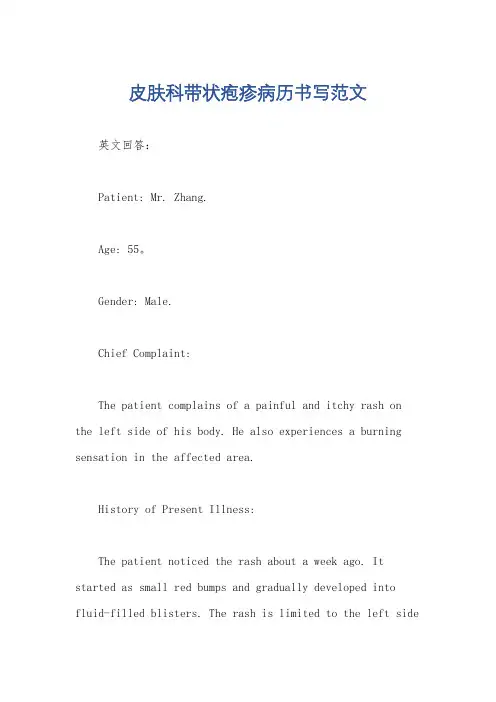
皮肤科带状疱疹病历书写范文英文回答:Patient: Mr. Zhang.Age: 55。
Gender: Male.Chief Complaint:The patient complains of a painful and itchy rash on the left side of his body. He also experiences a burning sensation in the affected area.History of Present Illness:The patient noticed the rash about a week ago. It started as small red bumps and gradually developed into fluid-filled blisters. The rash is limited to the left sideof his chest and back, following a dermatomal distribution. The patient reports severe pain in the affected area, which is exacerbated by touch and movement. He also experiences tingling and numbness in the same area. The patient denies any recent trauma or injury to the affected site.Past Medical History:The patient has a history of hypertension and type 2 diabetes, which are well-controlled with medication. He has no known allergies and has not undergone any surgeries in the past.Social History:The patient is a non-smoker and denies any alcohol or drug abuse. He works as an office manager and has no significant exposure to chemicals or irritants.Family History:There is no family history of skin diseases or othersignificant medical conditions.Physical Examination:On examination, there is a rash consisting of grouped vesicles and erythematous papules in a dermatomal pattern involving the left side of the chest and back. The rash is tender to touch and shows no signs of infection. There are no other significant findings on general physical examination.Diagnosis:Based on the clinical presentation and examination findings, the patient is diagnosed with herpes zoster, also known as shingles.Treatment:The patient will be prescribed antiviral medication, such as acyclovir, to reduce the duration and severity of the rash. Pain management will be initiated with analgesics,such as acetaminophen or nonsteroidal anti-inflammatory drugs (NSAIDs). The patient will also be advised to keep the affected area clean and dry, and to avoid scratching or picking at the blisters to prevent secondary infection. Follow-up will be scheduled in one week to monitor the progress and adjust the treatment plan if necessary.Prognosis:With appropriate treatment, the rash and pain associated with herpes zoster typically resolve within 2-4 weeks. However, some patients may continue to experience postherpetic neuralgia, a persistent pain that can last for months or even years after the rash has healed.中文回答:患者,张先生。
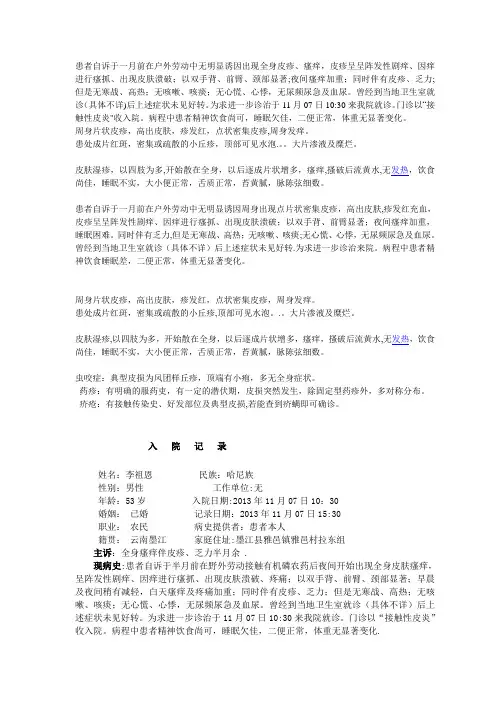
患者自诉于一月前在户外劳动中无明显诱因出现全身皮疹、瘙痒,皮疹呈呈阵发性剧痒、因痒进行瘙抓、出现皮肤溃破;以双手背、前臂、颈部显著;夜间瘙痒加重;同时伴有皮疹、乏力;但是无寒战、高热;无咳嗽、咳痰;无心慌、心悸,无尿频尿急及血尿。
曾经到当地卫生室就诊(具体不详)后上述症状未见好转。
为求进一步诊治于11月07日10:30来我院就诊。
门诊以“接触性皮炎"收入院。
病程中患者精神饮食尚可,睡眠欠佳,二便正常,体重无显著变化。
周身片状皮疹,高出皮肤,疹发红,点状密集皮疹,周身发痒。
患处成片红斑,密集或疏散的小丘疹,顶部可见水泡.。
大片渗液及糜烂。
皮肤湿疹,以四肢为多,开始散在全身,以后逐成片状增多,瘙痒,搔破后流黄水,无发热,饮食尚佳,睡眠不实,大小便正常,舌质正常,苔黄腻,脉陈弦细数。
患者自诉于一月前在户外劳动中无明显诱因周身出现点片状密集皮疹,高出皮肤,疹发红充血,皮疹呈呈阵发性剧痒、因痒进行瘙抓、出现皮肤溃破;以双手背、前臂显著;夜间瘙痒加重,睡眠困难。
同时伴有乏力,但是无寒战、高热;无咳嗽、咳痰;无心慌、心悸,无尿频尿急及血尿。
曾经到当地卫生室就诊(具体不详)后上述症状未见好转.为求进一步诊治来院。
病程中患者精神饮食睡眠差,二便正常,体重无显著变化。
周身片状皮疹,高出皮肤,疹发红,点状密集皮疹,周身发痒。
患处成片红斑,密集或疏散的小丘疹,顶部可见水泡。
.。
大片渗液及糜烂。
皮肤湿疹,以四肢为多,开始散在全身,以后逐成片状增多,瘙痒,搔破后流黄水,无发热,饮食尚佳,睡眠不实,大小便正常,舌质正常,苔黄腻,脉陈弦细数。
虫咬症:典型皮损为风团样丘疹,顶端有小疱,多无全身症状。
药疹:有明确的服药吏,有一定的潜伏期,皮损突然发生,除固定型药疹外,多对称分布。
疥疮:有接触传染史、好发部位及典型皮损,若能查到疥螨即可确诊。
入院记录姓名:李祖恩民族:哈尼族性别:男性工作单位:无年龄:53岁入院日期:2013年11月07日10:30婚姻:已婚记录日期:2013年11月07日15:30职业:农民病史提供者:患者本人籍贯:云南墨江家庭住址:墨江县雅邑镇雅邑村拉东组主诉:全身瘙痒伴皮疹、乏力半月余 .现病史:患者自诉于半月前在野外劳动接触有机磷农药后夜间开始出现全身皮肤瘙痒,呈阵发性剧痒、因痒进行瘙抓、出现皮肤溃破、疼痛;以双手背、前臂、颈部显著;早晨及夜间稍有减轻,白天瘙痒及疼痛加重;同时伴有皮疹、乏力;但是无寒战、高热;无咳嗽、咳痰;无心慌、心悸,无尿频尿急及血尿。
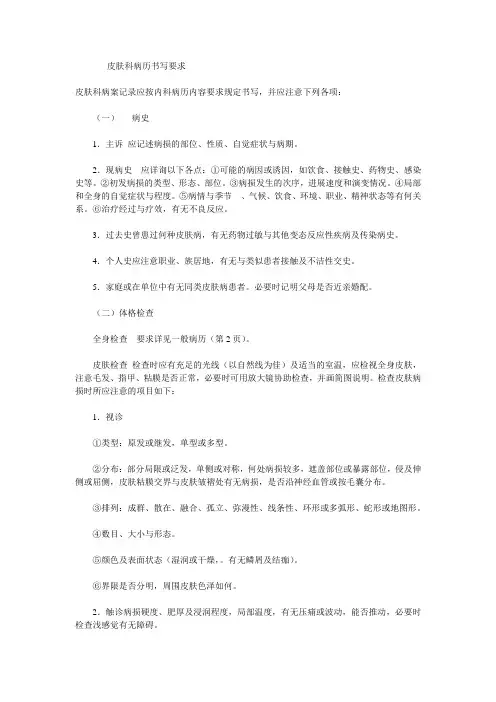
-----------皮肤科病历书写要求皮肤科病案记录应按内科病历内容要求规定书写,并应注意下列各项:(一)病史1.主诉应记述病损的部位、性质、自觉症状与病期。
2.现病史应详询以下各点:①可能的病因或诱因,如饮食、接触史、药物史、感染史等。
②初发病损的类型、形态、部位。
③病损发生的次序,进展速度和演变情况。
④局部和全身的自觉症状与程度。
⑤病情与季节、气候、饮食、环境、职业、精神状态等有何关系。
⑥治疗经过与疗效,有无不良反应。
3.过去史曾患过何种皮肤病,有无药物过敏与其他变态反应性疾病及传染病史。
4.个人史应注意职业、族居地,有无与类似患者接触及不洁性交史。
5.家庭或在单位中有无同类皮肤病患者。
必要时记明父母是否近亲婚配。
(二)体格检查全身检查要求详见一般病历(第2页)。
皮肤检查检查时应有充足的光线(以自然线为佳)及适当的室温,应检视全身皮肤,注意毛发、指甲、粘膜是否正常,必要时可用放大镜协助检查,并画简图说明。
检查皮肤病损时所应注意的项目如下:1.视诊①类型:原发或继发,单型或多型。
②分布:部分局限或泛发,单侧或对称,何处病损较多,遮盖部位或暴露部位,侵及伸侧或屈侧,皮肤粘膜交界与皮肤皱褶处有无病损,是否沿神经血管或按毛囊分布。
③排列:成群、散在、融合、孤立、弥漫性、线条性、环形或多弧形、蛇形或地图形。
④数目、大小与形态。
⑤颜色及表面状态(湿润或干燥,。
有无鳞屑及结痂)。
⑥界限是否分明,周围皮肤色泽如何。
2.触诊病损硬度、肥厚及浸润程度,局部温度,有无压痛或波动,能否推动,必要时检查浅感觉有无障碍。
3.压诊以手指或玻片压迫局部,了解玻片下病损的色调及有无皮内出血。
了解水肿是凹陷性还是非凹陷性。
4.刮诊用钝器在病损上轻刮,观察有无糠粃样鳞屑。
或检视鳞屑下面病损情况,如有无点状出血现象等。
5.嗅诊检查病损及分泌物有无特殊臭味。
6.皮肤划痕试验以钝器划痕后观察局部皮肤有无条状风团形成。
-----------皮肤科病历举例入院记录仇天柱。
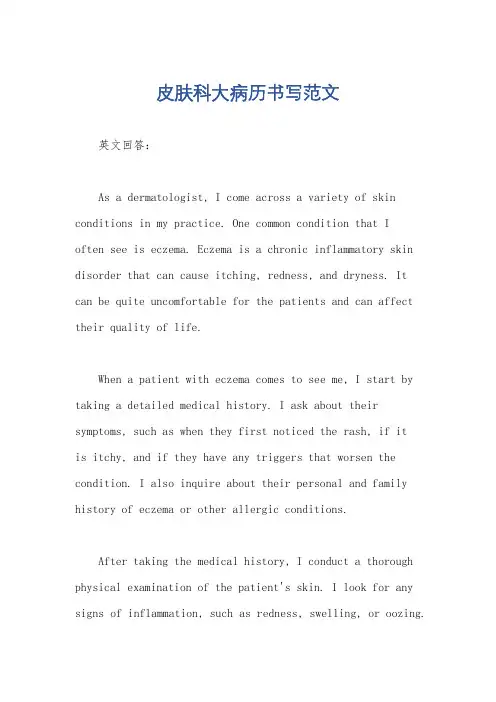
皮肤科大病历书写范文英文回答:As a dermatologist, I come across a variety of skin conditions in my practice. One common condition that Ioften see is eczema. Eczema is a chronic inflammatory skin disorder that can cause itching, redness, and dryness. It can be quite uncomfortable for the patients and can affect their quality of life.When a patient with eczema comes to see me, I start by taking a detailed medical history. I ask about their symptoms, such as when they first noticed the rash, if itis itchy, and if they have any triggers that worsen the condition. I also inquire about their personal and family history of eczema or other allergic conditions.After taking the medical history, I conduct a thorough physical examination of the patient's skin. I look for any signs of inflammation, such as redness, swelling, or oozing.I also inspect the affected areas for any secondary infections that may have developed due to scratching.In some cases, I may need to perform additional tests to confirm the diagnosis or rule out other skin conditions. These tests may include a skin biopsy or patch testing to identify specific allergens that may be triggering the eczema.Once the diagnosis is confirmed, I discuss the treatment options with the patient. I explain that eczemais a chronic condition that cannot be cured, but it can be managed effectively. I recommend a combination of lifestyle modifications and medications to control the symptoms.Lifestyle modifications may include avoiding triggers such as certain fabrics or detergents that irritate the skin. I also advise patients to keep their skin moisturized and to avoid excessive bathing or hot water, as it can dry out the skin further.In terms of medications, I may prescribe topicalcorticosteroids to reduce inflammation and itching. In severe cases, I may prescribe oral corticosteroids forshort-term use. Other options include topical calcineurin inhibitors, antihistamines, and immunomodulators.Regular follow-up visits are essential to monitor the patient's progress and adjust the treatment plan if necessary. I encourage my patients to ask questions and express any concerns they may have during these visits. Itis important to have open and honest communication toensure the best possible outcome.中文回答:作为一名皮肤科医生,我在我的实践中经常遇到各种皮肤疾病。
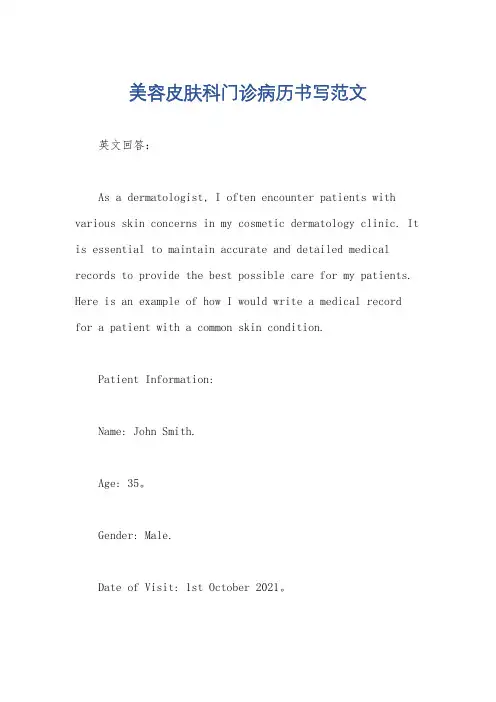
美容皮肤科门诊病历书写范文英文回答:As a dermatologist, I often encounter patients with various skin concerns in my cosmetic dermatology clinic. It is essential to maintain accurate and detailed medical records to provide the best possible care for my patients. Here is an example of how I would write a medical recordfor a patient with a common skin condition.Patient Information:Name: John Smith.Age: 35。
Gender: Male.Date of Visit: 1st October 2021。
Chief Complaint:The patient presented with a complaint of persistent acne on his face.History of Present Illness:The patient reports that he has been experiencing acne breakouts for the past six months. He mentions that the acne primarily affects his forehead, cheeks, and chin. The patient has tried over-the-counter acne treatments without significant improvement. He is concerned about the appearance of his skin and the negative impact it has on his self-esteem.Past Medical History:The patient has no significant past medical history. He has never experienced any skin conditions before.Review of Systems:The patient denies any other symptoms or complaints. There is no history of allergies or sensitivities to medications.Physical Examination:Upon examination, the patient has multiple comedones, papules, and pustules on his forehead, cheeks, and chin. The lesions are predominantly inflammatory with some evidence of scarring. The rest of the physical examination is unremarkable.Assessment and Plan:Based on the patient's history and physical examination findings, the diagnosis of moderate acne vulgaris is made.I explained to the patient that acne is a common skin condition caused by a combination of factors such as excess oil production, clogged pores, bacteria, and inflammation.I discussed the treatment options with the patient, including topical retinoids, benzoyl peroxide, and oral antibiotics. I also emphasized the importance of a properskincare routine and lifestyle modifications, such as avoiding excessive sun exposure and maintaining a healthy diet.I prescribed a topical retinoid cream to be applied once daily in the evening, along with a benzoyl peroxide wash to be used twice daily. I also prescribed an oral antibiotic to be taken daily for six weeks to help reduce the inflammation and control the acne. I informed the patient about possible side effects and advised him to follow up in four weeks to assess the treatment's effectiveness and make any necessary adjustments.中文回答:作为一名皮肤科医生,在我的美容皮肤科门诊中,我经常遇到各种皮肤问题的患者。
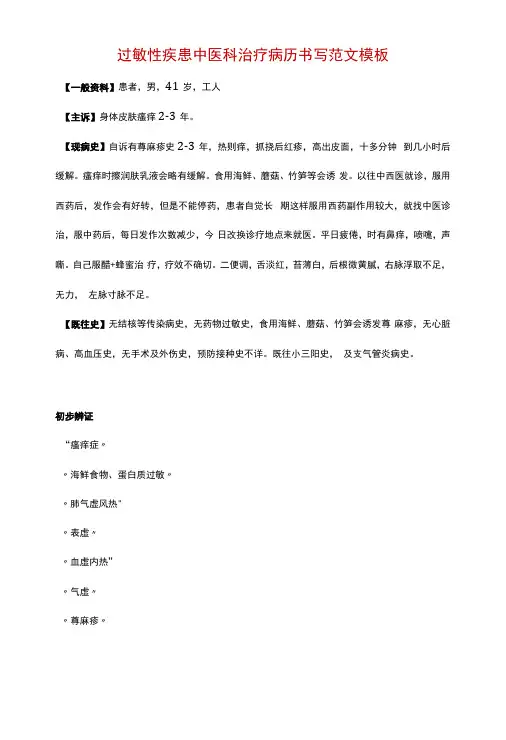
过敏性疾患中医科治疗病历书写范文模板【一般资料】患者,男,41岁,工人【主诉】身体皮肤瘙痒2-3年。
【现病史】自诉有尊麻疹史2-3年,热则痒,抓挠后红疹,高出皮面,十多分钟到几小时后缓解。
瘙痒时擦润肤乳液会略有缓解。
食用海鲜、蘑菇、竹笋等会诱发。
以往中西医就诊,服用西药后,发作会有好转,但是不能停药,患者自觉长期这样服用西药副作用较大,就找中医诊治,服中药后,每日发作次数减少,今日改换诊疗地点来就医。
平日疲倦,时有鼻痒,喷嚏,声嘶。
自己服醋+蜂蜜治疗,疗效不确切。
二便调,舌淡红,苔薄白,后根微黄腻,右脉浮取不足,无力,左脉寸脉不足。
【既往史】无结核等传染病史,无药物过敏史,食用海鲜、蘑菇、竹笋会诱发尊麻疹,无心脏病、高血压史,无手术及外伤史,预防接种史不详。
既往小三阳史,及支气管炎病史。
初步辨证“瘙痒症〃〃海鲜食物、蛋白质过敏〃〃肺气虚风热"〃表虚〃〃血虚内热”〃气虚〃〃尊麻疹〃〃血虚风燥"中医诊断尊麻疹(正气虚衰型)【治疗经过】治法,补中益气处方:逍遥散合补中益气汤加减,南沙参30g、黄茜30g、炒白术10g、陈皮10g. 柴胡10g、升麻10g、当归10g、白芍10g、茯苓10g、防风10g、乌药10g、五味子10g、蝉蜕10g、地肤子20g、白鲜皮20g、紫苏梗10g、甘草6g2012.12.15服药后,瘙痒发作次数减少,瘙痒程度也降低。
舌淡红苔薄白,后根微腻,防风IOg x乌梅10g,柴胡10g、五味子IOg x茨藜20g、黄精15g、地肤子20g、紫草15g、牡丹皮15g、川桐皮10g、地骨皮15g、桑白皮15g、白鲜皮30g、白土苓15g、甘草6g2012.12.30晨起偶有喷嚏,午不休则午后有头痛,疲倦,腰肾不适,尊麻疹发作次数大大减少。
遇热及洗澡时有发作,哮喘今年未有发作,寐可,脉沉,略无力,舌淡红、有齿痕,苔薄腻。
党参15g、炒白术10g、黄黄30g、陈皮10g、柴胡IOg s升麻IOg x当归10g.白芍15g、防风IOg x乌梅IOg x五味子10g. 蝉蜕10g、蜂房10g、连翘15g、紫草15g、甘草6g2013.1.19晨起喷嚏重,晨有头痛,气紧,胸闷、动则尤甚并伴呼吸困难,易疲倦,声嘶,舌尖红苔薄腻,补中益气汤+逍遥散+紫苑IOg x蜜麻黄5g、连翘15g、紫草20g、白鲜皮20g2013.3.30今日支气管炎,无晨起咳嗽,纳可,偶有气紧神疲乏力,腰痛,唇干,口干,舌淡红,苔薄黄,南沙参20g、北沙参20g、麦冬10g、五味子IOg x 瓜篓皮10g、法半夏10g、冬瓜子30g、慧苏仁30g、芦根30g、浙贝母10g、化橘红10g、鱼腥草30g、黄苓15g、白花蛇舌草10g、紫苏子10g、菜藤子IOg x孽苗子10g、大枣10g、甘草3g201346服药后哮喘气紧基本消失,遇冷或空气不流通处肤痒,眼干,无胸闷,皮肤瘙痒不甚,二便调,舌尖略偏红,苔薄腻,南沙参30g、百合10g.防风IOg、乌梅IOg x五味子IOg x诃子IOg x石菖蒲IOg x紫苏梗IOg x紫苑15g、白果5粒、白鲜皮15g、白皮15g、蔗藜15g、密蒙花10g、甘草6g、黄苓15g、浙贝母10g、生黄黄30g、黄精IOg2013.4.13近日咳嗽基本缓解,眼干、眼痒,易疲倦,纳可食可,皮肤基本不瘙痒,即使是偶尔有瘙痒,抓之无红痕,痒很快消退,舌边尖略红,苔白,后根腻,前方去强藜、密蒙花、浙贝母、紫苏梗,加白术30g、苍术20g、葛根30g、黄黄30g【病例讨论】辨证思路:患者已有两年尊麻疹发病史,又有小三阳病史,本肝不足,或因久病而生肝W 泼作时遇热则痒,发红疹汉患者平素疲倦,时有鼻痒,喷嚏,声嘶,左寸脉不足,故为气虚。
皮肤科病历书写的重点要求皮肤科病历记录应按内科病历内容要求规定书写,但应注意以下几点。
一、病史(一) 现病史:1.可能的病因或诱因,如饮食、接触史、药物史、感染等;2.初发病损的类型、形态、部位;病损发生的次序,进展速度和演变情况;3.局部和全身的自觉症状与程度;4.病情与季节、气候、饮食、环境、职业、精神状态等有何关系;5.治疗经过和疗效,有无不良反应。
(二) 既往史:曾患过何种皮肤病,有无药物过敏与其他变态反应性疾病。
有无性病史(如有则应询问其接触史、发病日期、种类、主要症状,曾否治疗及其治疗情况)。
(三) 个人史:应注意职业、居住地,有无与类似患者接触史等。
(四) 家庭或单位中有无与本病有关的病史等。
二、体格检查(一)一般体格检查:与内科相同。
(二)皮科检查:皮损是皮肤病的重要临床表现,精确辨认皮损特点是诊断皮肤病的重要依据。
(一)望诊:检查皮肤时光线要明亮,自然光最好,其次是日光灯。
除皮肤外,还应检查患者的毛发、指(趾)甲及粘膜。
检查时首先辨认皮损种类(分原发损害和继发损害两种),然后再观察其特征。
1.原发损害: 由皮肤病理变化直接产生的损害。
分为斑疹、丘疹、结节、水疱、风团、脓疱、肿瘤、囊肿等。
2.继发损害:由原发损害转变而来或由于治疗及机械损伤(如搔抓)所引起的损害。
分为鳞屑、痂皮、表皮剥脱或抓痕、浸渍、糜烂、皲裂、苔藓化、硬化、溃疡、萎缩(分表皮萎缩、真皮萎缩和表皮真皮同时萎缩)、瘢痕(分为萎缩性瘢痕和增生性瘢痕)、乳头样增殖(疣状损害或刺状损害)、皮肤异色等。
3.皮损特征(1)部位: 暴露部位、遮盖部位,伸侧,屈侧,间擦部位,皮脂分泌多的部位,皮肤粘膜交界部位。
(2)数目:皮疹数目少者,可直接计算其数目,较多者可写少数、多数、较少、较多。
(3)大小:以毫米、厘米测其直径大小,或以面积(平方厘米)、体积(立方厘米)计算。
(4)颜色:红、白、灰、黄等。
(5)形态: 平面、高起、扁平或凹陷。
过敏性皮炎首次病程记录XX医医院病历姓名:性别:年龄:住院号:首次病程记录2015年8月2日9时30分患者:xxx,主因“全身反复起皮疹50余年,再发加重5个月”门诊以“寻常型银屑病”收住院。
皮肤科检查:头颈部见相互融合的鳞屑性丘疹斑块,有白色鳞屑脱落,皮损突出于皮肤表面,界限清楚,遍布整个头部,鳞屑较薄,超出发际线。
病例特点1、患者为老年男性,反复起皮疹50余年,再发加重5个月,病程长。
2、头颈部见相互融合的鳞眉性丘疹斑块,有白色鳞眉脱落,皮损突出于皮肤表面,界限清楚,遍布整个头部,鳞屑较薄,超出发际线,头部可见轻微束状发。
Auspitz征阳性,甲受累,表现为“顶针状”凹陷,四肢有2*2cm大小皮损散在分布。
3、有青霉素、头孢、磺胺类过敏史。
三子有类似疾病史,患者姑妈有类似疾病史。
4、辅查: 1:过敏原特异性IgE 抗体筛查检测:总IgE浓度50- = 100IU/mL一:初步诊断;1:寻常型银屑病2:日光性皮肤炎?三诊断依据: 1. 患者为老年男性,反复起皮疹50 余年,再发加重5个月,病程长。
2、头颈部见相互融合的鳞屑性丘疹斑块,有白色鳞屑脱落,皮损突出于皮肤表面,界限清楚,遍布整个头部,鳞屑较薄,超出发际线,头部可见轻微束状发。
Auspitz 征阳性,3、甲受累,表现为“顶针状”凹陷,四肢有2*2cm 大小皮损散在分布。
三鉴别诊断: 1: 扁平苔癣:皮损为多角形扁平紫红色丘疹,可融合鳞屑性斑块,受累,病程慢性2:脂溢性皮炎:皮损为边缘不清的红斑,上覆细小的黄色油腻鳞屑,毛发可稀疏,变细,脱落,但无束状发。
四、入院诊断:1: 寻常型银屑病2:日光性皮肤炎五、诊疗计划: 1:I1 级护理,2:忌辛辣刺激饮食。
3:查血常规、尿常规、肝功能、心电图。
4.抗炎抗过敏,支持治疗5.对症治疗。
-----------呼吸内科病历示例入院记录林长生,男,68岁,已婚,浙江嵊县藉,汉族,上海越剧院退体琴师。
因反复咳嗽,咯痰22年,心悸、气急、浮肿2年,加重半月,于1991年12月7日下午门诊入院。
患者自1969年起,每遇发作持续7~10天,经四环素、枸橼酸维静宁(咳必清)等药治疗,即可好转。
每年发作2~3次,多在秋末冬初时。
工作、生活不受影响。
1981年以来,咳嗽、咯痰加重,早晚尤剧,有时伴气短。
每日痰量约10~20ml,为白色泡沫样,需青霉素等药物治疗方可缓解。
每次持续3个月以上,天气转暖,则上述症状缓解。
上楼、干重活时,有心慌、气急感,但日常生活尚可自理。
曾多次到地段医院就诊,诊断为“慢性支气管炎,肺气肿”。
经常服用止咳、祛痰、平喘药。
1989年冬起,咳嗽及咯白色泡沫痰终年不停,且无明显季节性。
时有发热,多在38℃左右。
痰量每日50~60ml,发热时痰量可增至100ml 左右,且呈黄色脓性痰,伴气急、气喘、心悸、双下肢浮肿。
动则气急、心悸加重。
曾在本市³³医院住院三次,诊断均为慢性支气管炎、肺气肿、肺心病。
经青霉素、链霉素、氨茶碱、氢氯噻嗪、氨苯蝶啶等药治疗,心悸、气急好转,浮肿消退。
出院后,日常生活不能完全自理,有时静卧亦觉气急。
此次于11月23日受凉后,上述症状又发作。
咯黄色脓性痰,不易咯出。
心悸、气急加重,双下肢浮肿,尿量减少,口唇发绀。
进食少许即觉上腹部饱胀不适,并有轻度恶心。
经青霉素、链霉素、消咳喘、氢氯噻嗪等药治疗未见好转。
于今日送我院求诊。
检验白细胞计数11³109/L,中性80%,X线胸片示“两肺透亮度增加,肺纹理紊乱、增多,右肺下动脉干横径18mm”。
今日下午入院。
平素身体较差,幼年曾患“麻疹、水痘、流脑、流腮”等传染病,1965年曾患“流感”。
1985年经X线钡餐摄片检查诊断为“胃下垂”,目前仍有胃纳欠佳,食后上腹部饱胀感。
1980年因尿潴留诊断为“前列腺肥大”。
皮肤科病历书写常用术语瘙痒疼痛水肿肿胀压痛针刺样痛烧灼感疱壁薄易破溃疱壁厚疱液清大小不等形态不一红斑水肿性红斑白斑色素减退斑色素沉着斑瘀点瘀斑丘疹毛囊性丘疹炎性丘疹毛周角化性丘疹粉刺斑块斑丘疹风团结节水疱大疱血疱脓疱丘疱疹囊肿鳞屑银白色鳞屑糠秕状鳞屑粘着性鳞屑油腻性鳞屑浸渍糜烂渗出脱屑溃疡坏死皲裂抓痕结痂血痂厚痂蜜黄色痂瘢痕萎缩性瘢痕增生性瘢痕苔藓样变萎缩角化增厚表皮坏死松解散在分布密集分布群集性分布簇集性分布对称分布单侧分布全身泛发弥漫性线状排列带状排列串珠状排列沿血管分布沿肋间神经分布向心性分布伸侧屈侧间擦部皱折部暴露部位接触部位界限清楚界限不清圆形椭圆形多角形不规则形环状表面光滑表面粗糙扁平隆起半球形圆锥形乳头状疣状菜花状中央脐凹基底较宽基底较窄基底呈蒂状浸润增厚萎缩变薄松驰紧张周围绕有红晕质硬柔软融合互不融合蜡样光泽尼氏征薄膜现象点状出血现象Auspitz征皮肤划痕征Wood灯检查醋酸白试验同形反应Koebner现象压之不褪色虹膜现象,靶样损害,头发呈束状全身弥漫性潮红肿胀Wickham纹蝶形红斑Gottron征多形性损害毛细血管扩张雷诺现象变性坏死凋亡核固缩核碎裂核尘核溶解萎缩间变异型性机化角质形成细胞中性粒细胞嗜酸性粒细胞肥大细胞淋巴细胞组织细胞上皮样细胞Langhans巨细胞多核巨细胞角化过度角化不全角化不良圆体谷粒颗粒层增厚颗粒层减少棘层肥厚假上皮瘤样增生表皮萎缩细胞内水肿气球样变细胞间水肿海绵形成棘层松解基底细胞液化变性色素失禁凹空细胞表皮内水疱表皮下水疱Munro微脓疡Kogoj微脓疡Pautrier微脓疡亲表皮性毛囊角栓鳞状涡角囊肿乳头状瘤样增生境界带收缩间隙透明变性胶样变性嗜碱性变性淀粉样变性纤维蛋白样变性纤维素沉积纤维素样坏死黏液变性弹力纤维变性渐进性坏死干酪样坏死脂质沉积钙沉积血栓形成肉芽组织肉芽肿结核结节异物肉芽肿麻风结节栅栏状肉芽肿祼结节增生性萎缩脂膜炎。
皮肤科门诊病历范文30份
患者姓名,张三性别,男年龄,45岁科别,皮肤科门诊号,2021001。
主诉,患者自述全身瘙痒、皮疹,伴有发热、头痛、乏力等症状。
现病史,患者于一周前出现全身瘙痒、皮疹症状,起初为局部皮肤红斑、丘疹,后逐渐扩散至全身,伴有明显瘙痒感。
同时出现发热、头痛、乏力等全身不适症状,就诊于当地医院,给予抗过敏治疗,症状缓解后出院。
但停药后症状再次加重,遂来我院就诊。
既往史,无特殊。
个人史,患者有烟酒史,无药物过敏史。
家族史,无遗传性疾病史。
体格检查,患者全身皮肤可见不规则形状的红斑、丘疹,表面糜烂,伴有明显
瘙痒感。
全身淋巴结未触及肿大。
体温37.8摄氏度,生命体征平稳。
辅助检查,皮肤刮片检查示真菌孢子及丝状菌菌丝阳性。
诊断,真菌感染性皮肤病。
治疗方案,口服抗真菌药物,外用抗瘙痒药物,避免刺激性食物及饮料,注意
个人卫生,避免过度疲劳,定期复查。
随访计划,患者需定期复查,密切观察病情变化,如有不适症状应及时就诊。
医师签名:日期:
以上病历资料由医生认真记录,如有疑问请及时咨询医生。
皮肤美容科门诊病历
病历编号:2022001
姓名:张三性别:男年龄:35岁职业:教师
主诉:面部长期出现色斑,皮肤粗糙
现病史:患者自述面部长期出现色斑,皮肤粗糙,经常感到不适,
影响日常生活。
无其他不适症状。
既往史:无手术史、外伤史、过敏史,无慢性病史。
家族史:无遗传性疾病史。
个人史:平时作息规律,饮食健康,无不良嗜好。
皮肤检查:面部皮肤呈现色素沉着,散在的黑色斑块,质地稍粗糙,无明显皮疹或溃疡。
诊断:面部色斑、粗糙皮肤
治疗方案:1. 中药面膜:清热解毒、祛斑美白 2. 光子嫩肤:改善肤色,收缩毛孔 3. 局部祛斑霜:帮助淡化黑色素沉积
注意事项:1. 避免阳光直射,外出时需做好防晒措施 2. 忌食辛辣刺激性食物,多吃水果蔬菜 3. 定期复诊,按医嘱使用药物及护肤品处方:
1. 中药面膜 2盒(口服外用)
2. 光子嫩肤疗程 5次
3. 局部祛斑霜 1
支
随访计划:每周一次复诊,观察皮肤变化,根据效果调整治疗方案。
医师签名:日期:2022年1月5日。
病历书写-皮肤科病历
皮肤科病历
1(现病史
(1)发病的原因和诱因:如与饮食、职业、用药、生活环境、情绪及其他内外因素等的关系。
(2)疾病的初发情况:病期、部位、损害性质、前驱症状等。
(3)疾病的发展情况:皮疹的发展顺序、速度和规律。
(4)自觉症状:主要症状及伴发的其他系统症状。
(5)发病后的治疗情况:方法、药名、剂量、效果及反应。
(6)复发情况及规律。
(7)传染性皮肤病应详细询问传染源、传播途径和传播方式。
2(过去史
以往有无类似病史:过敏性皮肤病(如药疹、接触性皮炎)应详细询问过敏史。
3(个人史
职业、婚姻、嗜好、文化程度。
4(家族史
近亲及远亲中有无同本病相关的病史、父母是否近亲结婚。
5(专科检查
观察皮疹应注意下列特点:
(1)部位:按解剖部位描述。
(2)性持:区别是原发疹还是继发疹,是一种性质的皮疹还是多种性质的皮疹。
(3)形态:圆形、椭圆形、多角形、环形、线形、不规则形等。
(4)数目:可数或不可数,数目少应直接记数。
(5)大小:用cm或mm表示,也可用实物比喻。
(6)色泽:除区别颜色外,应注意表面光泽。
(7)皮损边缘和界限:清楚、不清、整齐、不整齐。
(8)表面情况:干燥、湿润、平坦、光滑、粗糙、隆起、菜花状等。
(9)分布:全身性、局部性、单侧性、对称性,是否沿神经、血管和淋巴管走行分布等。
(10)排列:线状、带状、环状或弧状,散在或融合,孤立、群集或不规则。
(11)基底情况:狭窄或宽阔,有无蒂及浸润等。
(12)有无感觉障碍,必要时进行痛、触和温觉检查。
--------------------------------------------------------------------------------。